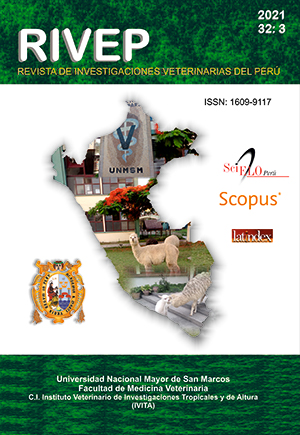Frequency of fascioliasis in cattle and Fasciola hepatica in Lymnaeidae snails in the district of Huanca, Arequipa, Peru
DOI:
https://doi.org/10.15381/rivep.v32i3.17607Keywords:
Fasciola hepatica, fascioliasis, associated factors, Lymnaeidae, Lymnaea, HuancaAbstract
The aim of this study was to determine the frequency of fascioliasis in cattle and its associated factors, as well as the frequency of infection with larval stages in Lymnaeidae snails in the livestock area of the Huanca district in Arequipa, Peru. In total, 179 samples of bovine, ovine and equine faeces, and 561 Lymnaeidae snails were collected. The associated factors were determined by applying an epidemiological survey for each livestock species, through the interview with the owners. Fasciola hepatica eggs obtained from faecal samples were analysed using the modified four-sieve technique. The snails (n = 484) were crushed on slides to release and analyse the larval stages of the trematode, while 77 snails were processed using the Pointier technique for taxonomic identification. The frequency of Fasciola hepatica in cattle was 46.4%, being higher in sheep and horses, in animals that were fed with alfalfa and natural pastures, and in those that drank water from the ditches and the river. The variable livestock species was established as a factor associated with fascioliasis. The frequency of infection in the Lymnaeidae was 7.4%. The snails belonged to the genus Lymnaea.
Downloads
Downloads
Published
Issue
Section
License
Copyright (c) 2021 Edel Valkan Chavez Arce, Guido Zumarán

This work is licensed under a Creative Commons Attribution 4.0 International License.
AUTHORS RETAIN THEIR RIGHTS:
a. Authors retain their trade mark rights and patent, and also on any process or procedure described in the article.
b. Authors retain their right to share, copy, distribute, perform and publicly communicate their article (eg, to place their article in an institutional repository or publish it in a book), with an acknowledgment of its initial publication in the Revista de Investigaciones Veterinarias del Perú (RIVEP).
c. Authors retain theirs right to make a subsequent publication of their work, to use the article or any part thereof (eg a compilation of his papers, lecture notes, thesis, or a book), always indicating the source of publication (the originator of the work, journal, volume, number and date).










